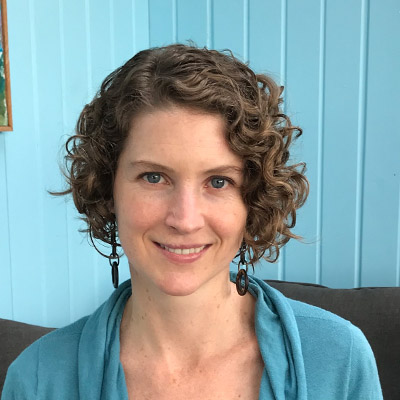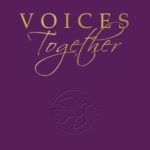Katie Graber, Anneli Loep Thiessen and Sarah Kathleen Johnson share a glimpse into the new resource, Guide to Voices Together Songs and Resources with Connections to Indigenous Communities in Canada and the United States, which was recently released by the Voices Together team.
This article is part of our series on Voices Together, the worship and song collection from MennoMedia, in partnership with Mennonite Church USA and Mennonite Church Canada.
 Katie Graber is an ethnomusicologist who studies race and ethnicity in a variety of contexts, including Mennonite music, American music and European opera. She teaches classes on Western music history and world music at the Ohio State University, and she leads singing at her church in Columbus, Ohio. She chaired the Intercultural Worship committee for the Voices Together project, and currently co-directs the Anabaptist Worship Network and serves as a member of the TogetherInWorship.net leadership team.
Katie Graber is an ethnomusicologist who studies race and ethnicity in a variety of contexts, including Mennonite music, American music and European opera. She teaches classes on Western music history and world music at the Ohio State University, and she leads singing at her church in Columbus, Ohio. She chaired the Intercultural Worship committee for the Voices Together project, and currently co-directs the Anabaptist Worship Network and serves as a member of the TogetherInWorship.net leadership team.
 Anneli Loepp Thiessen is a Ph.D. candidate in the interdisciplinary music research program at the University of Ottawa, where her dissertation examines how religious, social and political values inform women’s participation in the Christian music industry. She is a co-director of Anabaptist Worship Network and was a committee member for the Voices Together hymnal.
Anneli Loepp Thiessen is a Ph.D. candidate in the interdisciplinary music research program at the University of Ottawa, where her dissertation examines how religious, social and political values inform women’s participation in the Christian music industry. She is a co-director of Anabaptist Worship Network and was a committee member for the Voices Together hymnal.
 Sarah Kathleen Johnson is assistant professor of liturgy and pastoral theology at Saint Paul University in Ottawa, Ontario. She is a practical theologian who studies Christian worship in the context of a changing North American religious landscape, liturgy and ethics, and Anabaptism in ecumenical context. Sarah served as the worship resources editor for Voices Together and is a member of the TogetherInWorship.net leadership team.
Sarah Kathleen Johnson is assistant professor of liturgy and pastoral theology at Saint Paul University in Ottawa, Ontario. She is a practical theologian who studies Christian worship in the context of a changing North American religious landscape, liturgy and ethics, and Anabaptism in ecumenical context. Sarah served as the worship resources editor for Voices Together and is a member of the TogetherInWorship.net leadership team.
_____________________________________________________________________________
Over the past several decades, Mennonites in the United States and Canada have learned many songs and prayers from around the world, aided by denominational hymnals and Mennonite World Conference songbooks. As our repertoire has grown, however, many congregations have largely overlooked materials emerging from Indigenous communities closer to home. Geraldine Balzer writes about this in a 2015 article in the “Conrad Grebel Review,” in which she wonders: “Have North American Mennonites, by drawing on the music of other places, forgotten to listen to this place?”
The Voices Together hymnal includes 13 songs and five worship resources with connections to a diversity of Indigenous communities in North America, and five of these resources have emerged from Indigenous Anabaptist contexts. These resources are included in the hymnal to help communities worship in solidarity with Indigenous neighbors.
In order to help congregations meaningfully engage these resources – and avoid overlooking Indigenous contributions – the recently published and freely available “Guide to Voices Together Songs and Resources with Connections to Indigenous Communities in Canada and the United States” (also available at Together in Worship) provides background information, leadership suggestions and practical guidance.
The introduction to this 33-page document reads:
“These songs and prayers with connections to Indigenous communities have been offered as gifts to the wider church. To receive them as gifts, it is necessary to sing them rather than set them aside. To sing these songs respectfully, with attention to the contexts from which they come, is not misappropriation — it is the intention of those individuals and communities who gave permission and encouragement to share these resources in Voices Together.”
These songs and resources in Voices Together come from many different sources and eras. Older examples include “Wakantanka (Many and Great)” (VT 128), which was written by Dakota Christian Joseph R. Renville and first published in the Dakota language in 1846. This song has been included in many English language hymnals since then, including Hymnal: A Worship Book. In Voices Together, we included both English and Dakota languages, in order to honor its full history. Another historical example is “Way, way, way” (VT 742), a lullaby from Ojibwe people that was transcribed by ethnomusicologist Frances Densmore, in her 1913 study “Chippewa Music.” As we describe in the guide, in more recent years, Ojibwe Anglican communities in Minnesota have added Christian liturgical words such as “Christ have mercy” or “Holy Spirit, come.”
Later 20th-century examples include materials connected to Cheyenne Mennonite communities, such as “Jesus A, Nahetotaetanome (Jesus Lord, How Joyful)” (VT 8) and “Ehane he’ama (Father God, You Are Holy)” (VT 59), which were received and sung by Cheyenne people, including in Cheyenne Mennonite congregations, well before they were published in the collection Tsese-Ma’heone-Nemeotȯtse (Cheyenne Spiritual Songs) in 1982 and Hymnal: A Worship Book in 1992. “Creation Is a Song / Ho’ė enemeohe” (VT 181) was written by Doug and Jude Krehbiel in 2003, inspired by the writings of peace chief and Mennonite pastor Lawrence Hart, and with help from Hart’s sister, Lenora Hart Holliman.
“Dooládó’ Shi Diyinda (What a Wonderful Savior)” (VT 562) was written in 1997 and is well known in Navajo Christian communities. It was first translated into English by the author, Daniel Smiley, for publication in Voices Together in 2020. More recently, Mohawk songwriter Jonathan Maracle wrote “There’s a River of Life” (VT 24), based on Revelation 22:1. Maracle is an active performer with his band The Broken Walls, whose website proclaims their goal is “communicating a message of restoration, dignity, self respect, and the Creator’s Love to all cultures.”
Many of these stories were known to the committee when we compiled Voices Together, as we consulted with published collections, as well as Indigenous individuals and communities, when developing the hymnal. As we did further research for this guide, we learned more context and history, and troubling stories about two resources came to light.
The thing that came to light is an increasing discomfort with the Voices Together ascription of “May the warm winds of heaven” (VT 1061) as a “Cherokee blessing.” During the compilation process, we reached out to Cherokee institutions and were unable to determine its provenance. We trusted other well-researched published sources, and we reproduced the ascription “Cherokee blessing” from another hymnal. More recently, however, we have been in contact with multiple people who believe this description is incorrect. You can learn more about our research process and input from Cherokee culture bearers in the guide. Of note, with the information we have at this time, we recommend that communities do not use this prayer as a way to honor Indigenous communities and histories. We provide an alternative in the guide, and of course, there are other options in Voices Together, as well.
The second story concerns “Hey ney yana (I Walk in Beauty)” (VT 836). This song was published in the United Church of Canada’s supplement More Voices in 2007, with Brooke Medicine Eagle credited as the writer and copyright holder. When the Voices Together committee contacted Medicine Eagle for permission to share the song, she gave permission and told us she learned the song from Ute children. In Voices Together, the song is ascribed “as taught by Brooke Medicine Eagle” to reflect her work recording and sharing the song. However, after the publication of Voices Together, committee members were informed that Medicine Eagle has faced controversy over the misrepresentation of Indigenous spirituality and her Indigenous heritage. We now question whether she has an adequately significant relationship to this song or Ute people to share the song and give permission in this way. At this point, we advise that communities only sing this song if they learn new information about its background or are led to sing it through relationships with Indigenous communities. Otherwise, we advise communities not to sing this song and instead to worship with other material discussed in the guide.
Conclusion
Keshia Littlebear-Cetrone, a Cheyenne Mennonite, describes giving and receiving songs as a process of forming relationships through giving and receiving gifts:
“I’m offering you a gift. I’m sharing these songs with you, as a gift. And that makes us bonded — in relationship. And in that relationship, I trust you to honor the songs that we’re sharing. You’re not going to get it perfect; it’s not going to sound just right. … I trust you to hold that song with respect and with honor, to say, ‘I’m going to carry this, and that makes us brothers and sisters; we’re connected in that way.’ And so, when white Mennonites approach this, I want them to approach it with respect and with a level of understanding.”
When engaged with care and sensitivity, the resources featured in this guide are a vital expression of solidarity with Indigenous Christians. Leaders should take time to practice pronunciation, learn background stories and share this information with their communities. Singing and praying these resources respectfully can help build habits of thought and action that can be integrated outside of worship, through community involvement with existing initiatives toward reconciliation with Indigenous peoples. Like Littlebear-Citrone suggests, singing and praying with Indigenous Christians bonds us in relationship. With time, reflection, diligence and action, these resources can become an important part of the journey toward reconciliation.
For more information on Voices Together, visit voicestogetherhymnal.org.
Click here to find the Guide to Voices Together Songs and Resources with Connections to Indigenous Communities in Canada and the United States.
The views and opinions expressed in this blog belong to the author and are not intended to represent the views of the MC USA Executive Board or staff.


